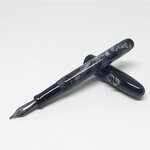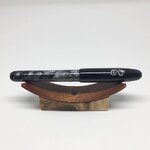Carl Fisher
Member
A simple little number with some special material. I wish more of this was available in the wild but sadly it's almost gone or people are hoarding their own supply and not willing to sell it off anymore.
Gray hatch celluloid body with some black ebonite trim and a simple stainless steel dragon roll stop.
Gray hatch celluloid body with some black ebonite trim and a simple stainless steel dragon roll stop.


